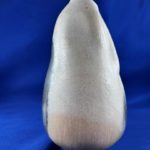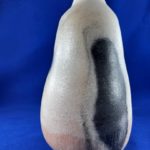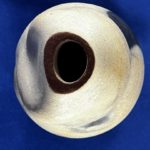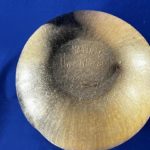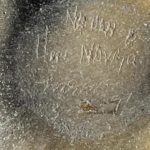o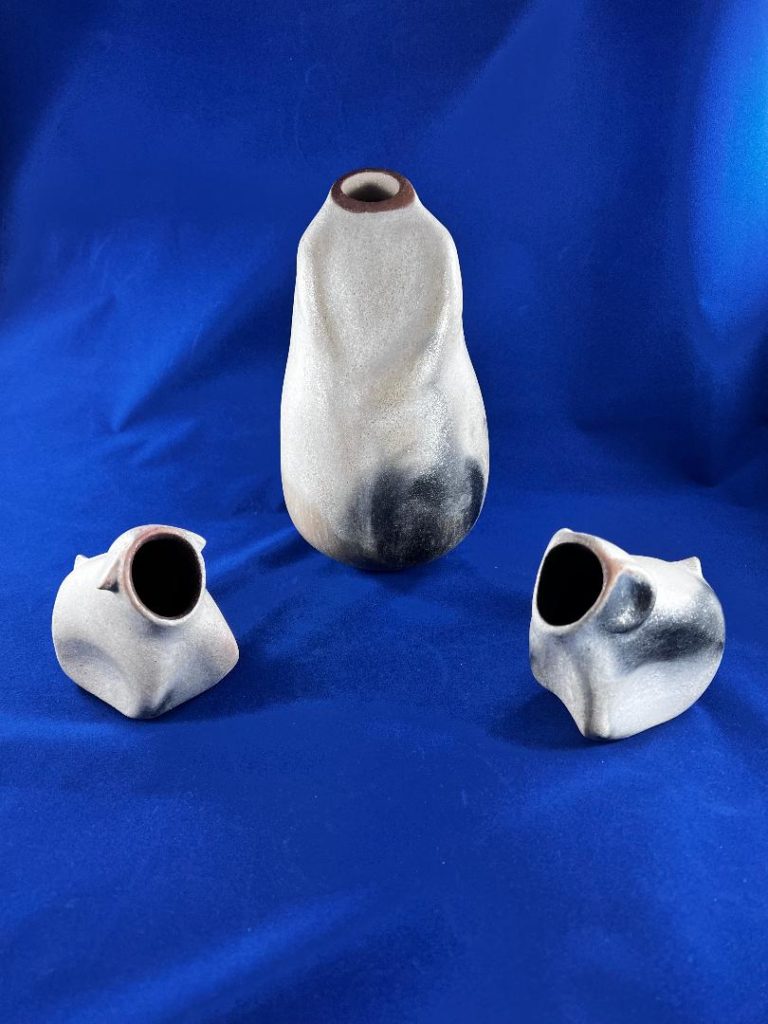
This is the first of three catalog entries about this group of pottery. Each begins with the same introduction.
Carrying almost no design, with only subtle suggestions of form, this small grouping of effigies stands in stark contrast to the 11 other beautifully decorated pots by Nathan Begaye in this collection. Compare this pot to the pot purchased just before this one, also by Nathan (2022-15). The contrast of form and design could not be greater, a testimony to Nathan’s restless creative genius.
At first look the shepherd and sheep discussed here seem plain and uninteresting, like a Zen rock garden without flowers.
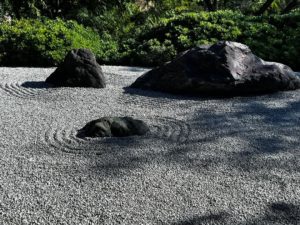
Spend some quiet time with this sheep herder and her flock, however, and these three enigmatic pots become immanent, evocative, and somewhat disturbing.
Their maker was a prodigy and an irascible human being whose conflicted life spun out-of-control and who died young. Among his oeuvre, this unpainted set might be unique; at least I have never seen another like it. Nathan was born to a Hopi mother and a Navajo father. Although his pottery is characterized by its tremendous variation in form and design, all other examples of Nathan’s pottery that I am aware of draw from his Hopi ancestry and carry pueblo-derived iconography. In contrast, both the theme and fabrication of the three pots under the rubric 2022-16 reflect his Navajo heritage.
The shepherd figure was fired on 3-2-91, the two sheep 5 days later. Since they share the same aesthetic, I assume that Nathan intended the three effigies to be seen together as a single grouping. Thus I discuss them as a joint entry in this catalog. Although they are a set, the three effigies will be discussed in separate catalog entries as items 2022-16a, 2022-16b and 2022-16c. I tried writing them as one entry, but found the result so complex that it was awkward.
Shepherdess/Shepherd:
Form:
The basic shape of this effigy is best seen from its rear, photograph #4 above. From its truncate neck the surface of the figure slopes gently outward 1.5-inches forming a slight shoulder, then falls vertically 2.5-inches where it swells slightly outward 4-inches before curving inward 3-inches to a 2-inch circular base. The resulting form is pear-shaped, though the curves are subtle and these measurements somewhat inexact.
The decapitated neck slopes about 30 degrees from back to front, its edge painted burnt siena, the only applied color on the effigy. The torso is modified only by two abstracted arms that are embossed by being pushed out from the inside when the clay was wet. The right arm is about 4-inches long; the left arm about 2.75-inches long, though (again) these details are subtle and the measurements perhaps inexact. The arms do not overlap, the end of the shorter arm pointing at but not touching the end of the longer arm.
Yet the surface of the vessel is much more varied than the description thus far would suggest. Judging from what can be seen on the interior of the neck, the jar was formed from a clay that fires dull light tan. At least the lower quarter of the exterior was polished with vertical strokes using a smooth stone, leaving an “onion-skin” pattern. Most of the effigy was then covered with a light white slip, although the lowest 25% of the vessel (revealing the onion-skin effect) was left unsliped and appears more tan than the upper, whiter surface. Finally the entire external surface of the pot was dusted with finely-ground mica dust, giving the pot a glittery, micaceous, finish. This sequence of production is a guess on my part.
The bottom of the effigy is signed with the expected marks:
- Nathan
- Hopi Navajo
- cloud cypher
- 3-2-91
….the last line being the creation date.
Design:
Except for that burnt sinena ring around the neck opening, this effigy is unpainted. Strictly speaking, that is the only design on the pot. However, the firing left prominent burn marks on the surface and these I believe were intentional, so I will discuss them under the rubric “design.”
The Navajo (Dine) are historically a nomadic people who arrived in the Southwest about 600 years ago. Pottery does not lend itself to extensive travel, and thus the Navajo have made pottery only relatively recently. [For a history of Navajo ceramics, see the entry for 2019-07.] Until recently the pottery produced since the Navajo settled in the Southwest was utilitarian: thick-walled, largely undecorated, unpainted, roughly smoothed with a dried corn cob, and made watertight by the application of hot pinion sap after firing. Pottery produced by this process typically displays black burn marks where the the fire used to bake the pot scorched the pot’s surface. [See 1969-07 for an example of a traditional Navajo pot.]
Such burn marks are a prominent feature of Nathan’s sheepherder. A large variegated burn mark covers much of the lower left surface of the effigy below the embossed arms. A darker 5 X 2-inch black strip marks the right side of her back. Smaller dark patches appear randomly across the pot’s surface. Wispy ghost-like black smudges waft off darker spots.
Design Analysis:
The decapitation edge of the neck is the only sharp element of the effigy. Its burnt sienna the only applied color. Both sharp edge and color seem abrupt and have an effect like a bullseye. . One expects a head; instead one gets to see the inside of a body. This could be a Madonna in a creche, except that that missing head is jarring.
The rest of the vessel is gentle and soothing. It requires some focus to see the pear form as a human. Its two arms are subtly-formed, their presence only suggestive. The neck and arms are the only specified features of the effigy. The contrast between the startling neck and soothing body creates visual tension. However the neck and arms also work together to attract the eye to the upper front of the form, since these are the only features that deviate from its pear shape.
While only the edge of the neck is painted, the rest of the body carries a great variation of pattern. The “onion-skin” finishing on the unslipped lower quarter of the body creates an almost subliminal pattern that attracts the gaze. The unslipped tan color of this onion-skin area also distinguishes it from the rest of the pot. The micaceous glitter of the jar somewhat more explicitly attracts a viewer’s eyes and unifies the the pot’s surface.
The black firing smudges run from wispy to dark, interrupting the gentle glitter of the surface. By using traditional the Navajo ceramic technique of letting the fire scorch this pot and create random black marks, Nathan was drawing upon his Navajo ancestry.
In short the smooth surface of the pot, although unpainted, shows great variation in
- finishing: smooth or onion-skin finish,
- finishing: micaceous or plain,
- coloring: white slipped or unslipped tan, and
- coloring: black smudge marks or clean.
A quick glance at this effigy reveals little but a plain form and surface. Understanding the complexity of form and finish requires consideration.
In contrast to all the other pottery by Nathan that is known to me, this pottery set is quintescently Navajo.
Sheep herding is the mainstay of the Navajo economy, so the theme of the set of figures is Navajo. Likewise this set is the only example by Nathan that I know of that uses traditional Navajo fabrication: rejecting painted decoration and instead using mica and random burn marks to decorate the pottery. This is Nathan Begay of Navajo ancestry, an aesthetic tradition that is not incorporated into his usual painted pots.
Like that Zen garden pictured above, meditating on the figures in this ensemble encourages an openness to meaning. For me this grouping is a Trinity with a mixed message of security and threat. The imposing sheep herder protectively guards the sheep in her care, both male and female. The missing head of the human leaves a bloody opening to the body’s interior: decapitation. The sheep cluster protectively near their guardian, but their gaping mouths bellow fear of present threats and future slaughter. Relationships, even between a sheep herder and her flock, are nurturing and peaceful but also violent. After all, the sheep are being raised to be killed. Life’s like that, both comfort and threat. Nathan uses these figures to convey this complexity of life to us, and he does so using both a Navajo theme and Navajo pottery technique.




